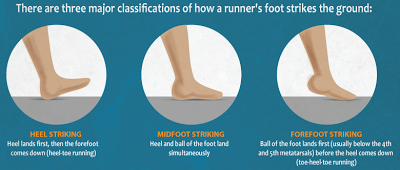Minimalist Shoes
A common question of our customers is “what is minimalist or barefoot running?” The book Born to Run, by Christopher McDougall, helped generate the recent popularity of barefoot running. There are definite pros and cons to minimalist running and footwear. We don’t have an opinion on the subject, but rather we try to help all runners reach their goals. The most common problem we see from runners attempting to go minimalist is a rise in injury. Too often they neglect to develop a plan that allows their body to adjust to a minimalist shoe. We always encourage customer to transition their footwear over time.
TERMS:
Heel to toe differenctial (drop): The difference in heel stack between the forefoot and the heel. Typically, a minimalist shoe is between 0-8 millimeters (mm). A zero drop (0 mm) means that the heel and forefoot are completely level. In the picture below, the drop would be 6mm.
Midf-foot vs. heel striking: A shoe with a high heel stack for cushion, encourages a heel strike. Lower drop shoes, with less cushion, encourage a mid-foot strike. A heel strike is synonymous with knee and back pain. It also acts as a break slowing momentum down. A forefoot strike can cause strain on the achilles tendon and calfs. Hence, the mid-foot strike, is a perfect balance for shock absorption and momentum.
Mobility:Another important part of minimalist shoe is mobility, or how flexible it is. A minimalist shoe should allow your foot to move as it wants. The simplest way to test this is to take the shoe in your hand and twist it in all directions. The most minimal shoes should be able to roll the toe back to the heel counter with ease.
TRANSITION PLAN
When transitioning to minimalist shoes, take your time. The lack of support and cushioning can be a shock to your system. The transition can take anywhere from three to twelve months. At a minimum you’ll want to start with a walk/run workout to break your feet and shoes in slowly. A sample would be run for 30 seconds, walk for 2 min for a total of 15 min. As your feet feel stronger, you’ll be able to progress your run, and shorten your walk.
In addition to progressing your foot strength, you’ll also want to transition your shoes. Especially if you are prone to injuries, or wear a very supportive shoe like the Brooks Adrenaline or Asics Kayano which are categorized as stability shoes for people who pronate. Here is a sample progression for a runner in a stability shoe, we’ll use one company for simplicity. You’ll want to wear the shoe until it wears out, and you are comfortable with running in less support.
- Brooks Adrenaline – 12mm – Stability
- Ghost -12 mm – Neutral
- Launch – 10mm -Neutral
- Pure Flow – 4mm – Neutral
MINIMALIST SHOES WE CARRY
ROAD
BROOKS Pure Flow – 4 mm
SAUCONY Type A6 – 4mm
ON Cloud – 6mm
ON CloudFlow – 6mm
ALTRA Instinct /Intuition – 0mm
NB Minimus – 4mm
TRAIL
SAUCONY Peregrine (trai) – 4mm
ALTRA Lone Peak -omm
BROOKS Pure Grit – 4mm

